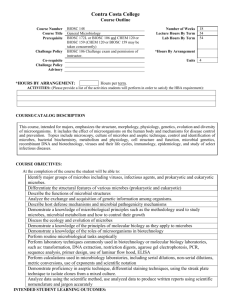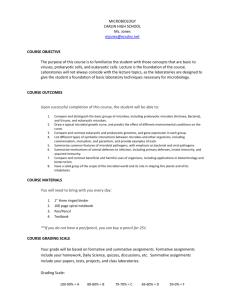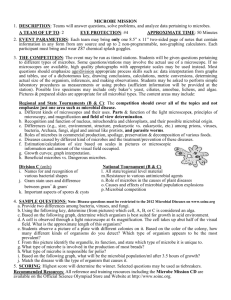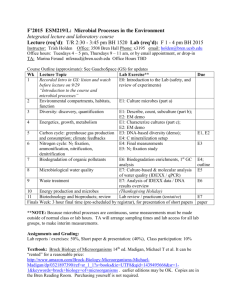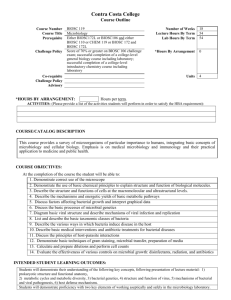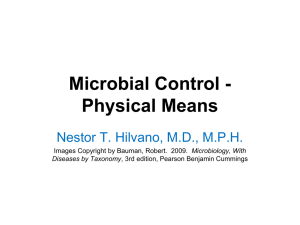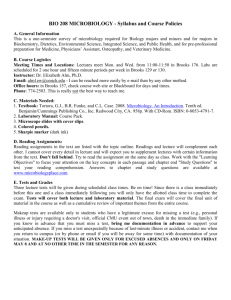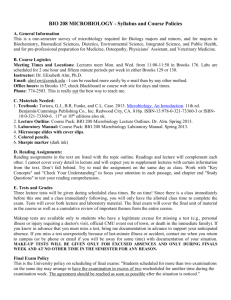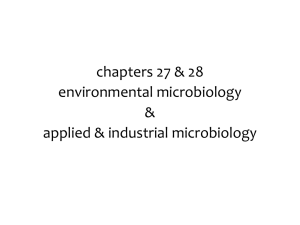BIOCS 148-S14 36KB Mar 31 2014 01:52:55 PM
advertisement
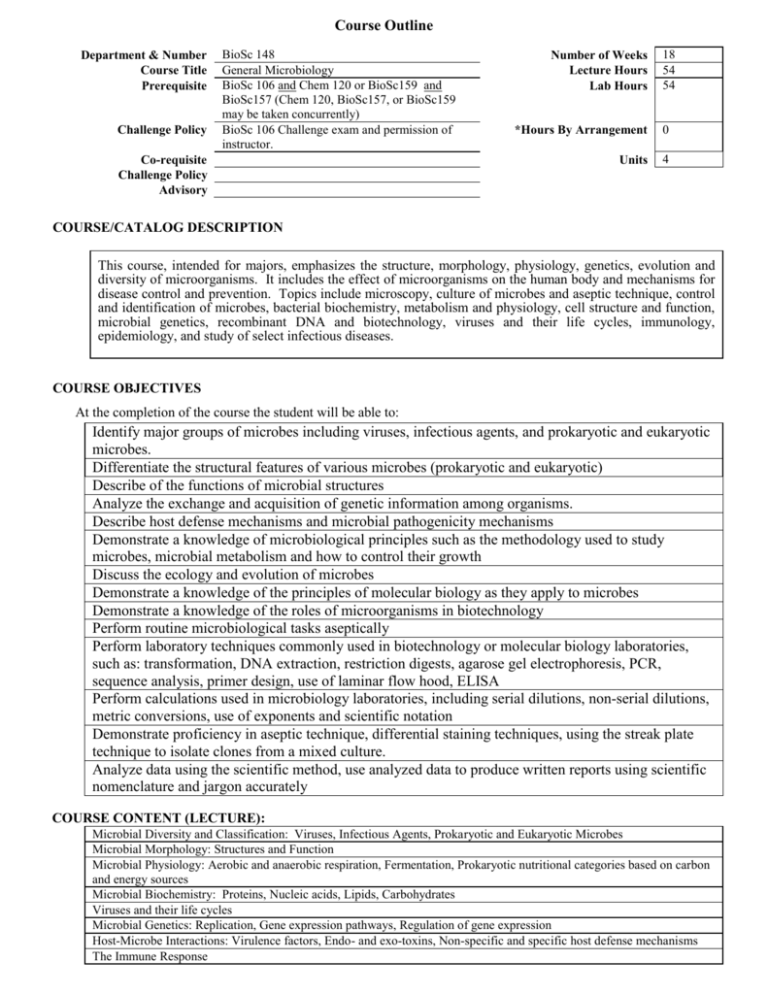
Course Outline Department & Number Course Title Prerequisite Challenge Policy BioSc 148 General Microbiology BioSc 106 and Chem 120 or BioSc159 and BioSc157 (Chem 120, BioSc157, or BioSc159 may be taken concurrently) BioSc 106 Challenge exam and permission of instructor. Co-requisite Challenge Policy Advisory Number of Weeks Lecture Hours Lab Hours 18 54 54 *Hours By Arrangement 0 Units 4 COURSE/CATALOG DESCRIPTION This course, intended for majors, emphasizes the structure, morphology, physiology, genetics, evolution and diversity of microorganisms. It includes the effect of microorganisms on the human body and mechanisms for disease control and prevention. Topics include microscopy, culture of microbes and aseptic technique, control and identification of microbes, bacterial biochemistry, metabolism and physiology, cell structure and function, microbial genetics, recombinant DNA and biotechnology, viruses and their life cycles, immunology, epidemiology, and study of select infectious diseases. COURSE OBJECTIVES At the completion of the course the student will be able to: Identify major groups of microbes including viruses, infectious agents, and prokaryotic and eukaryotic microbes. Differentiate the structural features of various microbes (prokaryotic and eukaryotic) Describe of the functions of microbial structures Analyze the exchange and acquisition of genetic information among organisms. Describe host defense mechanisms and microbial pathogenicity mechanisms Demonstrate a knowledge of microbiological principles such as the methodology used to study microbes, microbial metabolism and how to control their growth Discuss the ecology and evolution of microbes Demonstrate a knowledge of the principles of molecular biology as they apply to microbes Demonstrate a knowledge of the roles of microorganisms in biotechnology Perform routine microbiological tasks aseptically Perform laboratory techniques commonly used in biotechnology or molecular biology laboratories, such as: transformation, DNA extraction, restriction digests, agarose gel electrophoresis, PCR, sequence analysis, primer design, use of laminar flow hood, ELISA Perform calculations used in microbiology laboratories, including serial dilutions, non-serial dilutions, metric conversions, use of exponents and scientific notation Demonstrate proficiency in aseptic technique, differential staining techniques, using the streak plate technique to isolate clones from a mixed culture. Analyze data using the scientific method, use analyzed data to produce written reports using scientific nomenclature and jargon accurately COURSE CONTENT (LECTURE): Microbial Diversity and Classification: Viruses, Infectious Agents, Prokaryotic and Eukaryotic Microbes Microbial Morphology: Structures and Function Microbial Physiology: Aerobic and anaerobic respiration, Fermentation, Prokaryotic nutritional categories based on carbon and energy sources Microbial Biochemistry: Proteins, Nucleic acids, Lipids, Carbohydrates Viruses and their life cycles Microbial Genetics: Replication, Gene expression pathways, Regulation of gene expression Host-Microbe Interactions: Virulence factors, Endo- and exo-toxins, Non-specific and specific host defense mechanisms The Immune Response Disease Control/Prevention: Physical and chemical methods of microbial control, differentiated by prokaryotic target Microbial Evolution COURSE CONTENT (LAB): Microscopy techniques: Oil immersion, differential staining techniques Use of differential and selective media Microbial control: Physical and chemical methods (UV radiation, disinfectants and antiseptics, antibiotics) Aseptic and sterile technique: Benchtop, sample manipulation using a laminar flow hood DNA transformation of a plasmid clone, streak and Isolate a clone of bacteria, make a miniprep of plasmid DNA, restriction enzyme digest, run an agarose gel, analyze the plasmid genotype Identify an organism via PCR: Sequence analysis, primer design, troubleshoot reaction Identify an organism or protein using ELISA METHODS OF INSTRUCTION Lecture Laboratory exercises Team-based projects and discussions Homework problems Laboratory reports Laboratory practical exams Reports/presentations INSTRUCTIONAL MATERIALS Textbook Title: Author: Publisher: Edition/Date: Lab Manual Title: Author: Publisher: Edition/Date: Prescott’s Microbiology Wiley, Sherwood, Wolverton McGraw Hill 9th, 2013 Experiments in Microbiology: Biosc148 Levine, Perez, Matiasek, Krolikowski CCC Bookstore 2nd, 2013 COURSE EXPECTATIONS (Use applicable expectations) Outside of Class Weekly Assignments Weekly Reading Assignments Weekly Writing Assignments Weekly Math Problems Lab or Software Application Assignments Other Performance Assignments Hours per week 2 2 2 2 STUDENT EVALUATION: (Show percentage breakdown for evaluation instruments) 15 60 15 10 % % % % Quizzes and homework assignments Lecture and laboratory written and practical examinations Laboratory reports Technique demonstrations GRADING POLICY (Choose LG, CR/NC, or SC) X Letter Grade 90% - 100% = A 80% - 89% = B 70% - 79% = C 60% - 69% = D Below 60% = F Pass / No Pass 70% and above = Pass Below 70% = No Pass Prepared by: Katherine Krolikowski, PhD Content Review Date: October, 2013 Revised 04/13 Student Choice 90% - 100% = A 80% - 89% = B 70% - 79% = C 60% - 69% = D Below 60% = F or 70% and above = Pass Below 70% = No Pass
